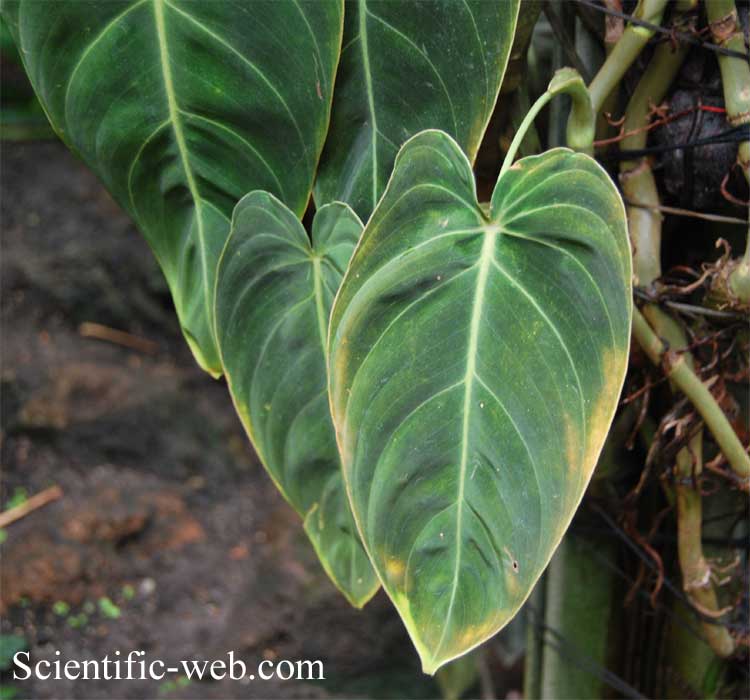
Philodendron melanochrysum, Photo: Michael Lahanas
Classification System: APG IV
Superregnum: Eukaryota
Regnum: Plantae
Cladus: Angiosperms
Cladus: Monocots
Ordo: Alismatales
Familia: Araceae
Subfamilia: Aroideae
Tribus: Philodendreae
Genus: Philodendron
Species: Philodendron melanochrysum
Name
Philodendron melanochrysum Linden & André, 1873
Synonyms
Heterotypic
Philodendron andreanum Devansaye, Rev. Hort. (Paris) 58: 36 (1886).
Philodendron grandidens auct., Rev. Hort. Belge Étrangère 13: 274 (1887).
Distribution
Native distribution areas:
Continental: Southern America
Regional:Northern South America
Colombia
References: Brummitt, R.K. 2001. TDWG – World Geographical Scheme for Recording Plant Distributions, 2nd Edition
References
Linden, J.J. & André, É.F., 1873. L'Illustration Horticole. Ghent & Brussels 20:198, t. 149.
Links
Govaerts, R. et al. 2018. Philodendron melanochrysum in World Checklist of Selected Plant Families. The Board of Trustees of the Royal Botanic Gardens, Kew. Published online. Accessed: 2018 Nov. 06. Reference page.
International Plant Names Index. 2018. Philodendron melanochrysum. Published online. Accessed: Nov. 06 2018.
The Plant List 2013. Philodendron melanochrysum in The Plant List Version 1.1. Published online. Accessed: 2018 Nov. 06.
Tropicos.org 2018. Philodendron melanochrysum. Missouri Botanical Garden. Published online. Accessed: 06 Nov. 2018.
USDA, ARS, Germplasm Resources Information Network. Philodendron melanochrysum in the Germplasm Resources Information Network (GRIN), U.S. Department of Agriculture Agricultural Research Service. Accessed: 08-Apr-12.
Vernacular names
Philodendron melanochrysum (also known as Black Gold Philodendron) is a species of flowering plant in the family Araceae, endemic to the wet Andean foothills of Colombia, growing at approximately 500m above sea level in the provinces of Chocó and Antioquia but widely cultivated elsewhere as an ornamental.[2][3][4]
It has been in cultivation (outside of South America since at least 1886, exhibited to Europeans via Veitch Nurseries by Messrs Veitch & Son under the synonym Philodendron andreanum as follows:
A striking Aroid, first discovered by M. Andre, of Paris, and subsequently introduced by us direct from New Granada; it is by far the finest species of Philodendron for decorative purposes ever brought under cultivation. Its stately foliage when fully developed may be compared, for size and effectiveness, with that of Anthurium veitchii and Anthurium warocqueanum.
The cordiform-lanceolate leaves are deflected vertically from a robust erect footstalk, and attain a length of four to five feet. When first expanded on the young plant they are of a decided scarlet tinge shaded with brown, when a little older they become a bronzy red-brown before finally changing to the normal bright velvety green of the mature leaves. Through all these changes the colors are relieved and enhanced by the white midrib and nerves that branch from it.
We received the award of a First Class Certificate for this plant at the Royal Horticultural Society's Show at Liverpool, in June, 1886, under the name of Philodendron grandidens, where it formed one of the principal attractions of the group of plants exhibited by us. We also received a Certificate of Merit for it from the Royal Botanic Society two years previous under the same name.[5]
One of the best climbing foliage plants for a conservatory, black gold philodendron has heart-shaped leaves that are typically 25 cm long, but in ideal conditions they can grow even longer. Young plants have smaller, broader, copper-red leaves, but when established they are quite superb; they have a velvety sheen on the blackish-green surface, and beautiful, pale green veins. The rare, insignificant flowers are best removed. Grow it up a moss pole and spray regularly to create humidity. Water freely when in full growth and add a monthly liquid feed; water sparingly in winter. Susceptible to scale insects and red spider mites.[6]
The name suffix "melanochrysum" means "black gold" and refers to "tiny golden sparkles" sometimes observed when the leaves of the adult plant (which are dark, almost black) are in sunlight.[7]
References
"Philodendron melanochrysum Linden & André". Plants of the World Online. The Trustees of the Royal Botanic Gardens, Kew. n.d. Retrieved July 29, 2020.
Kew World Checklist of Selected Plant Families
Govaerts, R. & Frodin, D.G. (2002). World Checklist and Bibliography of Araceae (and Acoraceae): 1-560. The Board of Trustees of the Royal Botanic Gardens, Kew.
Linden & André, Ill. Hort. 20: 198 (1873).
"New Or Rare Plants. Philodendron Andreanum". chestofbooks.com. Retrieved 2020-10-06.
Rosenfeld, Richard. Houseplants. New York: DK Publishing, Inc., 2004. 235.
"Philodendron melanochrysum". brightonbeach.ca. Retrieved 2022-01-19.
Retrieved from "http://en.wikipedia.org/"
All text is available under the terms of the GNU Free Documentation License

